Slow Living Tips for Modern Life
Table of contents

In today’s fast-paced world, the concept of slow living offers a refreshing perspective. It challenges the hustle culture, encouraging us to savor life’s simple pleasures. By adopting slow living, we can improve our mental health, forge deeper relationships, and find greater contentment in our daily routines.
Understanding Slow Living
Slow living is about intentionality and mindfulness. It’s a lifestyle choice that prioritizes quality over quantity, encouraging us to live at a more thoughtful pace. This movement pushes back against the constant rush of modern life and the need to do everything quickly.
The Principles of Slow Living
At its core, slow living revolves around a few key principles that guide our actions and decisions. These principles help us focus on what truly matters.
1. Mindfulness: Being present in the moment and fully engaging with what we’re doing.
2. Minimalism: Reducing clutter and focusing on what adds value to our lives.
3. Sustainability: Making choices that are environmentally conscious and sustainable.
4. Connection: Building meaningful relationships and community ties.
Benefits of Embracing Slow Living
Adopting slow living can bring numerous benefits to various aspects of our lives. It’s not just about slowing down; it’s about enriching our experience of life.
1. Improved mental health: Less stress and more peace of mind.
2. Better relationships: More time for family, friends, and community.
Physical Health Benefits
Slowing down can also have a positive impact on our physical health. Here’s how:
- Reduced stress levels can lead to lower blood pressure and a healthier heart.
- Taking time to prepare meals can lead to healthier eating habits.
By incorporating slow living, we can enhance not only our mental well-being but also our physical health.
Practical Tips for Living Slowly
Transitioning to a slow living lifestyle doesn’t have to be overwhelming. Here are some practical tips to help you get started:
| Tip | Description | Benefit |
|---|---|---|
| Declutter | Reduce physical and mental clutter. | Increased focus and peace of mind. |
| Mindful Eating | Enjoy meals without distractions. | Improved digestion and satisfaction. |
Implementing these tips can help you embrace a slower, more intentional way of living.
Integrating Slow Living into Daily Routine
Slow living can be woven into the fabric of our daily lives with small, deliberate changes.
Morning Routine
- Wake up 15 minutes earlier to enjoy a calm start to your day.
- Incorporate a short meditation or stretching session.
Beginning the day with intention sets a positive tone for the hours ahead.
Work-Life Balance
Finding a balance between work and personal life is crucial for slow living. Here’s how:
1. Set boundaries with work time and personal time.
2. Take breaks throughout the day to recharge.
Maintaining this balance can prevent burnout and improve productivity.
Challenges in Adopting Slow Living
While the benefits are clear, slow living can come with its own set of challenges. Understanding these can help us navigate the transition more effectively.
Societal Pressure
Our society often values productivity over well-being, making it challenging to slow down.
1. Embrace your pace: Understand that what works for others might not work for you.
2. Seek communities that support slow living.
By overcoming these societal pressures, you can fully embrace the benefits of slow living.
Conclusion
Slow living is a conscious choice to live more deliberately, placing emphasis on the quality of experiences rather than the quantity. By embracing this lifestyle, we can improve our health, well-being, and relationships. As with any lifestyle change, start small, and gradually integrate more aspects into your routine.
Sources:
1. Mindful Magazine
2. The Slow Home Podcast



